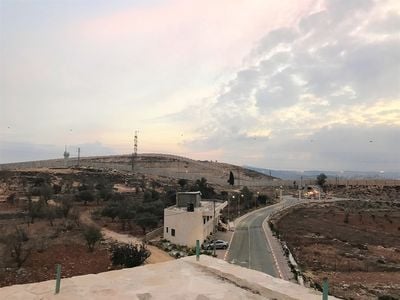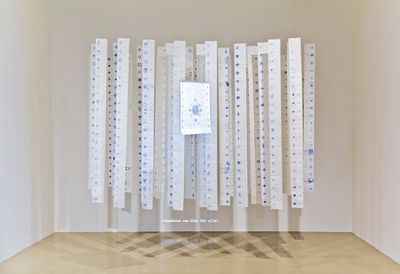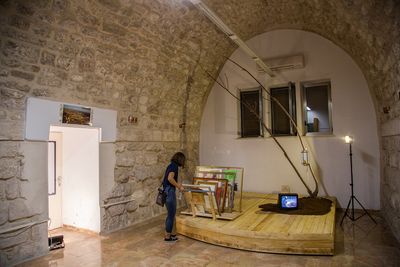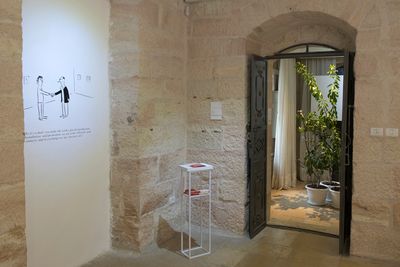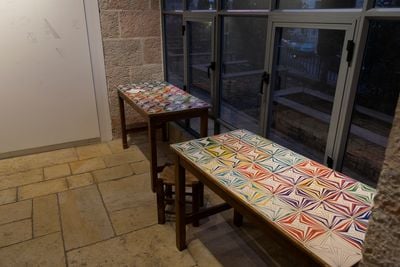Qalandiya International IV: Solidarity
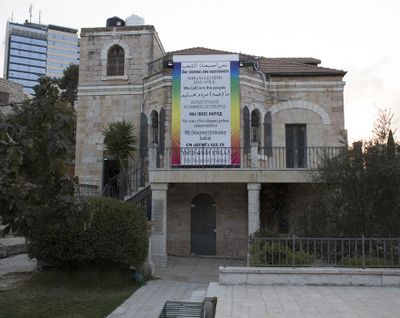
Hans Haacke, We are all the people (2003/2017). Exhibition view: Debt, Khalil Sakakini Cultural Center, Ramallah (6 October–15 November 2018). Courtesy Qalandiya International.
Written at the time of the Persian Gulf War of 1991, the long poem An Atlas of the Difficult World (1991) by American poet Adrienne Rich takes the reader on a poetic journey from California to Vermont, collecting stories and signs of a nation which, as the poet writes, has not met the basic needs of its citizens. Rich's poem interrogates national identity and patriotism in a time of war; it opens with a woman attempting to bear witness to the vital signs of the country, and travels across the geography of American history, closing with a testament of hope. Composed of 13 shorter poems or scenes of daily life, the work enacts solidarity through the poetics of connection. The fourth edition of Qalandiya International bore some resemblance to Rich's poem.
Held in several cities and villages across Palestine and organised by nine art organisations, Qalandiya International IV, Solidarity (3–30 October 2018), attempted to bridge time and space to reflect on the meaning and practice of solidarity. In Palestine, forms of solidarity are determined by the material conditions imposed by the Israeli occupation, which has created a fragmented geography, in which cities and villages are kept apart by walls and checkpoints. The disconnection and segregation produced by the long-standing occupation—not to mention economic dependency, real estate bubbles, and the pressure exercised by global capitalism—has created more internal political and social conflicts, and division. The question that Qalandiya International IV asks, then, is how artists, curators, writers, and cultural producers can practice solidarity amid such stakes.
I only caught a glimpse of the programme of shows, talks, walks, performances, visits and parallel events in the cities of Jerusalem, Ramallah, Al-Bireh, Birzeit, Bethlehem, Haifa, and Gaza, as well as the villages of Qalandiya, Al Jib, and Majdal Shams. During the opening days, I took a night bus to the Golan Heights, where we met artist Wael Tarabai from the human rights organisation Al-Marsad. Tarabai took us on a tour of the area surrounding the town of Majdal Shams, situated on the contested border with Syria in the Israeli-controlled area of the Golan, which is inhabited by a community of Syrian Druze: an ethnic, religious, linguistic, cultural, and political minority that resisted assimilation into Israel by holding firmly to their Syrian identity following the occupation of the territory in 1981.
In Majdal Shams, we attended the opening of an exhibition by artist Akram Al Halabi who, like many artists from this town, studied abroad in Damascus, Vienna, and Beirut. Upon his return to Palestine, Al Halabi founded the Fateh Al Mudarris Center for Arts and Culture with a group of local artists. For Qalandiya International IV, videos and drawings from Al Halabi's project Snowflakes (2009–2012) were on view at the Center. Between 2009 and 2012, the artist asked a total of 784 individuals he had casually met in public places across Venice, Vienna, Jerusalem, Ramallah, the Golan Heights, Munich, Stockholm, Umea and Rome, to write on invoice papers how they perceived themselves in the moment of their encounter with the artist. Al Halabi then added a series of geometric figures to the descriptions to create lines in the shape of fingerprints and snowflakes. The dye of the carbon papers turned blue upon pressure, allowing participants to receive a copy of their work.
In the exhibition space, long strips of invoice papers were suspended from the ceiling to form a walk-through geometric pattern. The artist describes the collaborative process of making the work as a metaphor for a multiple, porous, relational, and dialogically constructed identity—an idea which seems to pose a threat to national narratives, but seems deeply rooted in the ethos of Qalandiya International.
In Jerusalem, the Al Ma'mal Foundation opened the ninth edition of The Jerusalem Show (3–31 October 2018), curated by Jack Persekian and Kirsten Scheid at the Lutheran School and in the premises of Al Ma'mal and Gallery Anadiel in Old Jerusalem. Titled Jerusalem Actual & Possible, this year's edition sought to reclaim the imaginative capacity of art to recover old histories while refusing 'the given present'—an attempt at opening a gate to 'that which has no time, and a space for that which has no space'. The work of 22 mostly Palestinian artists was presented, among them Palestine Hosting Society (Mirna Bamieh & Suzanne Matar), Benji Boyadgian, and Adania Shibli.
Jumana Emil Abboud's multimedia installation God's Army (2018) is a powerful poetic commemoration of the voices of those whose lives and histories have been erased. The work takes as its point of departure Ihsan Hasan al-Turjman's Am al Jarrad (Year of the Locust: A Soldier's Diary and the Erasure of Palestine's Ottoman Past), along with extensive American photographic and archival documentation of the 1915 locust invasion of Palestine—a destructive plague that only added to the already difficult situation produced by droughts, war, disease, the crumbling of the Ottoman empire, and the British and French naval blockade. Inspired by Ihsan Hasan al-Turjman's life, Abboud created a stage on which a series of drawings depicting the exhausted look of a woman's face, the splattered carcass of a locust, and archival images were montaged and held together by frames. A video made of found footage was also on view, and several objects were carefully arranged around the scene, like the props of a play about to open, or that had already been staged.
Art's attempt to counter the systematic erasure of history returned in the exhibition Lydda —A Garden Dismembered (4 October 2018–15 January 2019) curated by Yazid Anani, Abed Al-Rahman Shabaneh, Vera Tamari, Eyad Issa, Amer Shomali, and Ziad Yousef Haj Ali, realised in cooperation between the A.M. Qattan Foundation and the Birzeit University Museum. Under the British mandate, the village of Lydda was supposed to become 'a modern utopian garden' mirroring the coloniser's 'imagined' biblical landscape of Palestine. In 1948, the year of the Nakba, the village's inhabitants were forced out of their homes and displaced forever. Some of the artists in Lydda directly address the political history of the place, like the video installation Lydda—Past, Present (2018) by the collective formed by Hadeel Yaqob, Manal Massalha, Razan Khalaf, and Tareq Khalaf: a two-channel video which brings together the same stories from the different perspectives of an Israeli military official and a displaced inhabitant of the village.
Other works in the show relied on poetics to explore the existential landscape produced by this 'dismembering', like Mahdi Baraghithi's vibrant series of collages, 'A visionary image of Lydda in my imagination since childhood' (2018). Composed using images taken from social media, the digital collages show a young man whose head has been replaced by colourful flowers, performing an exaggerated version of masculinity against backgrounds of floating cranes, domes, metal towers, and expensive cars. As a young refugee from Lydda who never visited the place, Baraghithi's compositions question the nostalgia for an idyllic world he has not experienced, in relation to the idea of heroic masculinity that, according to the artist, places undue emotional pressure on young men.
In Ramallah, the Khalil Sakakini Cultural Center opened Debt (6 October–15 November 2018), curated by Reem Shadid and Yazan Khalili with the assistance of Lina Bani Odeh. The exhibition posed a question that lay at the heart of Qalandiya International IV: How can/do Palestinian art practitioners and organisations work together when their very existence is marked by political, existential uncertainties, and the spectre of financial debt? Art institutions in Palestine are often run on low budgets, and are heavily dependent on an international network of art funds. With this in mind, the curators of Debt contemplated the possibility of embracing debt as a 'condition' that binds people together, and can potentially generate new forms of solidarity.
Due to budget limitations and the impossibility for many artists to travel to Ramallah, Debt's curators invited 17 artists—including Casey Asprooth-Jackson and Mujahed Khallaf, Jill Magid, and Omnia Sabri—to reflect on the notions of debt and solidarity. Some produced works that analyse existing institutional models and imagine how they could be rethought through new forms of relation and small acts of solidarity. For instance, Marwa Arsanios's booklet Towards a Feminist Organisation considers the case of Beirut, where, as Arsanios argues, post-war institutions were run like NGOs with precarious funding systems, and how this led to the privatisation of contemporary art and a division in the art scene.
Similarly, the intervention by Ayreen Anastas and Rene Gabri, Communist Museum of Palestine, considers a museum model that hosts its collection inside the homes of Palestinians. Participants signed up to take part in the project, offering to host objects in their own homes. The artists produced a series of tiles reading 'Communist Museum of Palestine', which will be given to those involved at a later stage of the project's realisation.
In the beautiful garden of the Riwaq organisation in Al-Bireh, Anastas and Gabri also engaged audiences in an exercise of sharing associations and words that come to mind when thinking about 'Communism', 'Museum', and 'Palestine'. There was an animated discussion around the word 'Communism', and we all agreed that the Western model of the 'Museum' is dead.
Aside from being an exhibition, Debt is a 'collective study', which manifested as a series of group meetings with local institutions, artists, academics, and art professionals in order to think about the practices of solidarity that are available or can be imagined to shift the political, social, and economic context of today's Palestine. The fourth of these meetings coincided with the opening of Qalandiya International IV. Yazan Khalili, who heads Khalil Sakakini Cultural Center, asked whether solidarity is able to remain loose and take multiple forms, without necessarily having to lead to a union. Here, some tensions emerged between those who insisted on the pragmatic need to unionise and formulate clear demands, and those who were more inclined to informal situations and networks.
While it is correct to say that debt is the common denominator of contemporary existence, an acknowledgement of debt, or its denial, can be seen as a factor in any act of solidarity when it comes to surviving—or resisting—contemporary conditions, as exemplified by Qalandiya International IV as a whole. To act in solidarity entails unearthing silenced histories, resisting disconnections and erasure, and opening channels of transmission that bridge time and space. —[O]

